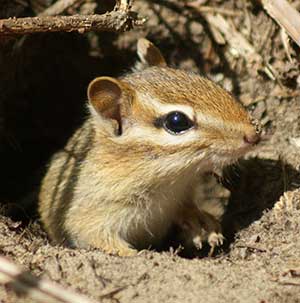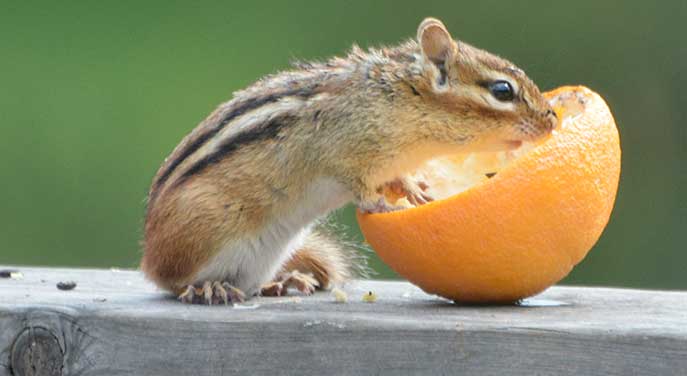 Although over 200 kinds of squirrels can be found across the globe, 25 of those are chipmunks and all but one of these species of chipmunk lives in North America. The outlier is the Siberian Chipmunk which can only be found in Asia.
Although over 200 kinds of squirrels can be found across the globe, 25 of those are chipmunks and all but one of these species of chipmunk lives in North America. The outlier is the Siberian Chipmunk which can only be found in Asia.
In Canada, we have several kinds of squirrels – Eastern Gray, Red, Eastern Fox, Douglas’s, Eastern and Northern Flying Squirrels, Least, Yellow Pine, Red-tailed, Townsend’s and Eastern Chipmunks, Franklin’s, Richardson’s, Columbian, Arctic, Thirteen-lined and Golden-mantled Ground Squirrels, Black-tailed Prairie Dog, Yellow-bellied, Vancouver Island and Hoary Marmot, and the Groundhog or Woodchuck.
The marmots and woodchucks are squirrels but look very different from their kin. As we know, all the squirrels are quite habituated to humans, and some frequently share our space and sometimes even our homes!
The one squirrel that seems to capture our hearts the most is the chipmunk. Who doesn’t love a chipmunk? They are adorable, endearing, seemingly trusting and oh so cute! I don’t think anyone ever goes – “Oh, look at that ugly creature” when they see a Chippie. But show someone an opossum, rat or skunk and the reaction is very different.
 A single chipmunk can gather almost 175 acorns in a single day |
 Although sometimes a nuisance, they are nearly always delightful and tolerable |
| Related Stories |
| The amazing wild horses of Sable Island
|
| Monarch butterflies here today, gone tomorrow
|
| Venturing deep into the heart of Vietnam |
So maybe it’s time to delve a bit into the chipmunk’s life. I’ve chosen the Eastern Chipmunk as my representative species – it is a tiny creature that sports various shades of tan, gray, black and white in a diagnostic pattern that is easily recognizable.
Our rural and urban yards are perfect for them, but their natural habitat is hardwood forests with well-drained lands and small crevices, rock piles or loose earth so they dig burrows. The burrows are vertical at first, then move laterally so that the various ‘‘rooms” are protected and dry. These burrows are complex in design and can extend up to four meters in length. Along their path, they contain various chambers for food storage (usually the lowest chambers to keep food dry and cool), comfortable vegetation-lined sleeping quarters and even a garbage dump/washroom zone for refuse/feces disposal.
The tunnels are kept very clean. Chipmunks are very adaptable and resourceful. Mine even live in the small drainage tiles we have that funnel the rainwater away from the house – it must get pretty damp in there on occasion!
In late March or early April, they emerge from their winter hibernation. Unlike some hibernators, they actually don’t store fat in their bodies in the fall but instead store caches of food that they periodically eat during the winter during brief periods of activity.
Breeding takes place in the early spring. About a month later, two to seven young are born – naked, blind and weighing only about three or four grams. They are dependent on their parents for some time. At about day eight, they start to grow some fur, and the patterning starts to fill in on their bodies. It isn’t until about day 30 that they can see and are also then able to venture out from the nest. A second brood might be raised if the first is lost or food is plentiful.
Food consists of nuts, berries, insects, flower bulbs and tubers, bird eggs and nestlings (if they can find them) and, of course, bird seed. They are comical to watch as they fill their face pouches with up to 60 seeds at a time to the point where their head seems twice as large as normal!
Okay, time for some fun facts:
- a group of chipmunks is called a scurry
- a single chipmunk can gather almost 175 acorns in a single day
- chipmunks are very vocal and have different calls for different reasons. If a predator is terrestrial, such as a snake or fox, they emit a string of high-pitched chips, but if the predator is aerial they emit lower ‘‘chuc” sounds. It is believed that other animals like Red Squirrels and particularly Groundhogs recognize these sounds and react accordingly.
Do their stripes help with survival? Likely yes. The same as a zebra’s stripes make them less visible to predators, a chipmunk living in the dappled light of the forest can easily ‘‘disappear” in the shadows.
Although they can sometimes become a nuisance, they are nearly always delightful and tolerable!
Geoff Carpentier is a published author, expedition guide and environmental consultant. Visit Geoff on LinkedIn, Instagram and Facebook.
For interview requests, click here.
The opinions expressed by our columnists and contributors are theirs alone and do not inherently or expressly reflect the views of our publication.
© Troy Media
Troy Media is an editorial content provider to media outlets and its own hosted community news outlets across Canada.

